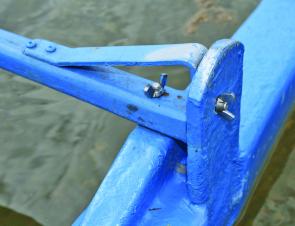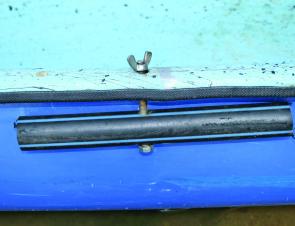Canoe and kayak fishing has become immensely popular over the last couple of years. When you think about this type of fishing, it’s not hard to understand the attraction of these affordable fishing platforms. Canoes and kayaks are lightweight and highly manoeuvrable and are ideal for accessing hard-to-get-to waterways, which often contain relatively ‘untouched’ populations of fish.
By removing the need for a boat ramp, there are very few places where you can’t take them and they making fishing simple. At the most basic level all you need is a rod and reel, a small box of lures, a drink and a shady hat and you are fishing. There is no major pack or unpack at the end of the day, no trailer or motor to wash down and no big fuel bill either. As a way of getting on the water, few craft are as accommodating or as easy on the wallet as a kayak or canoe.
If having all the latest gadgets is your thing, then the option is always there to fit your chosen personal watercraft out to whatever level you desire. Add a Fishfinder, multiple rod holders, remote anchoring system, electric motor or even a live bait tank (I kid you not!). It seems the level of fit-out is limited only by your budget and imagination.
I have to admit that my own canoe is a very basic three man Canadian type. It’s an old fibreglass model which has definitely seen better days, but that doesn’t worry me in the slightest. It gets me to places that I just can’t go in my bigger boat and tossing it in off the bank or dragging it over obstacles just puts a few more scrapes in the gel coat and adds to the old girl’s character.
What my canoe does have is an outrigger and this simple little addition makes it even more versatile than it otherwise would be. With the outrigger fitted, two anglers can easily stand and fish from it and at times we have even had a couple of us fly fishing out of it without any problems. My eldest son and I regularly use it to toss surface lures for bass in the local lake (which doesn’t have a formed boat ramp) and we have even used it to sneak into the top end of Lake Awoonga to chase barra. And let me tell you, it takes canoe fishing to a whole new level when you hook a metre plus barra from one of these things.
There are probably a lot of canoes out there which aren’t getting used to their full capacity due to concerns about stability and possible capsize. And while you can go out and buy commercially made outriggers for most new canoes, if you have an oldie like mine, then you may want to consider building one yourself.
I must admit that I didn’t make my own outrigger, as it came with the canoe when I bought it second hand. However, looking at it, it wouldn’t take much in the way of manufacturing skill to put together and the pictures give you some idea of what is involved.
Basically, the outrigger itself has been carved from foam (the surfboard type) and then fibreglassed over. It has had a couple of pieces of board added to it and some stainless bolts moulded in to provide anchoring points for the outrigger poles.
The poles are made of hardwood and have a single hole drilled through each end. The end that attaches to the outrigger has been fitted with a metal strip, which has been bent out and then had the end folded over at right angles. This strip provides a second anchor point for each pole and when everything is bolted together, the strip is held under tension, helping to keep everything snugly locked in place.
Attaching the poles to the canoe is quite simple and shows a good deal of lateral thinking. On the outrigger side, two holes have been drilled through the rolled gunnel and a couple of bolts and a flat plate clamp down on the pole. On the other side, a single bolt through the pole is all that is required. The trick is that all the bolts have been stuck through a short length of heavy-duty poly pipe first which fits snugly under the gunnel. Quite ingenious really, the pipes spread the load and help prevent the weight of the outrigger from ripping the bolts out of the fibreglass.
The outrigger itself is shaped like a mini canoe and when paddling only the very bottom is in contact with the water, reducing drag and keeping the canoe easy to paddle. Manoeuvrability is only slightly compromised but this is more than made up for by the extra stability.
You may wonder why hardwood was used for the poles rather than something lighter like aluminium. The weight of the heavy hardwood poles hanging off the outrigger side of the canoe is what makes it so stable. In fact, the previous owner even had a mast and sail fitted to it (hence the canoe’s flat rear end which had a rudder attached). He used to sail it around the local river mouth without any problems.
Assembly is pretty simple really and anybody with a minimum of handyman skills should be able to make one up over a weekend. If you do decide to give it a try and would like any further clarification, I can always be reached on my email address that is --e-mail address hidden-- . Happy canoeing!
Facts
Dimensions
| Poles: | 2.3m x 35mm x35mm hardwood |
|---|---|
| Outrigger: | 2m x 225mm x 100mm f/g over foam |
| Bolts: | 3/8” x 4” stainless with Butterfly nuts. |
| Poly Pipe: | 1 ½” in diameter x 12” long. |

This shows how the outrigger poles attach to the rigger itself. Note the bent metal strip that acts like a spring to hold things under tension.

The use of poly pipe to hold the bolts in place is a nice bit of lateral thinking.

These are the bolts that fasten the poles to the canoe.

The outrigger make the canoe easily stable enough to stand up in. Also note the cut-off garden chairs which are great back savers.

James with a healthy Aussie bass taken on a Trollcraft Fizz Stick while fishing out of the canoe. Stealth fishing at its best!

The hydrodynamic shape of the outrigger reduces drag through the water. As a bonus, the outrigger poles make a great place to lash a fly rod to while it is not being used.




